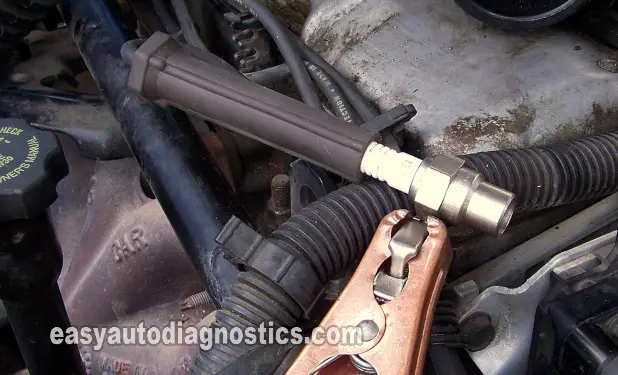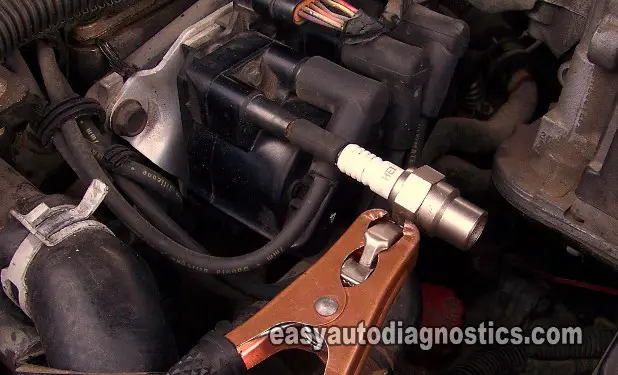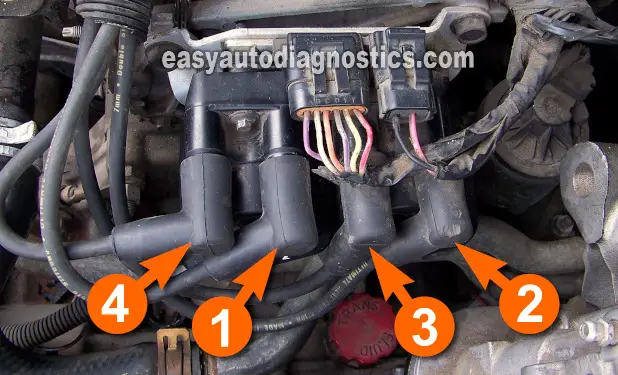TEST 1: Spark Test

The very first thing you need to do is confirm that all spark plug wires are firing off spark.
I recommend you test all cylinders for spark whether you have a misfire diagnostic trouble code and know what cylinder is the one misfiring or not.
Also, the successful outcome of all of your tests depends on using an HEI spark tester and that you start your troubleshooting from TEST 1 and follow the indicated next test.
IMPORTANT: Cylinders #1 and #4 get spark from the same coil pack and are called 'paired cylinders' and cylinders #2 and #3 get spark from the other one and are also called 'paired cylinders'.
These are the test steps:
- 1
Remove the spark plug wire from the spark plug.
- 2
Connect the HEI spark tester to the spark plug wire you just disconnected.
- 3
Have your helper crank the car while you observe the HEI spark tester.
CAUTION: The engine will probably start (if you're testing a misfire condition), so be careful and take all necessary safety precautions. - 4
You'll get one of two results: spark or no spark.
- 5
Repeat this spark test on the remaining spark plug wires.
Let's take a look at what your test results mean:
CASE 1: You got spark from all spark plug wires. This test result indicates all of the ignition coil packs are good.
This also confirms the ignition control module (ICM) and the crankshaft position (CKP) sensor are working correctly. Go to: Other Causes Of Misfires.
CASE 2: You got NO SPARK from any of the spark plug wires. This result indicates one of two things, either the ignition control module (ICM) is bad or the crankshaft position sensor is bad.
The next round of tests will help you troubleshoot them both, go to: TEST 5: Ignition Module's Triggering Signal.
CASE 3: You got NO SPARK from only one spark plug wire. This result indicates one of two things, either the spark plug wire is bad or the ignition coil is bad.
The next round of tests will help you troubleshoot this further, go to: TEST 2: Spark Test Directly On Coil Tower.
CASE 4: You got NO SPARK from two spark plug wires that feed 'paired cylinders'. This result indicates one of two things, either the ignition coil pack or the ignition control module (ICM) is bad.
The next round of tests will help you troubleshoot this further, go to: TEST 3: Ignition Coil Power Circuit Test.
CASE 5: You got NO SPARK from two spark plug wires that feed 'non-paired cylinders'. This result indicates one of two things, either both ignition coil packs are bad or the spark plug wires are bad.
The next round of tests will help you troubleshoot this further, go to: TEST 2: Spark Test Directly On Coil Tower.
TEST 2: Spark Test Directly On Coil Tower

IMPORTANT: This test step applies only if you got a no-spark result in TEST 1 on: 1) only one spark plug wire or 2) two different spark plug wires that DO NOT feed two 'paired cylinders'.
The next step is testing for spark directly on the ignition coil to determine if the spark plug wire is bad or if the ignition coil pack is bad.
This is what you need to do:
- 1
Remove the spark plug wire that did not fire off spark in TEST 1 from its ignition coil tower.
- 2
Connect the HEI spark tester to the ignition coil tower with a small piece of vacuum hose (see the photo above).
- 3
Connect the HEI spark tester to the battery negative (-) terminal with a jump start cable.
- 4
Have your assistant crank the engine.
- 5
The HEI spark tester should do one of two things: spark or not spark.
- 6
Test the other ignition coil tower in the exact same way.
NOTE: This test applies only if you got a no-spark result from two spark plug wires that feed spark to two 'non-paired cylinders'.
Let's take a look at what your test results mean:
CASE 1: The spark tester sparked. This result confirms the spark plug wire is bad.
Replacing all of the spark plug wires as a set should solve the misfire diagnostic trouble code (DTC) and misfire condition your Cavalier or Sunfire is experiencing.
CASE 2: The spark tester DID NOT spark. This result confirms the ignition coil is fried.
Replacing the coil pack connecting to this spark plug wire (that didn't fire spark in TEST 1) should solve the misfire diagnostic trouble code (DTC) and misfire condition your Cavalier or Sunfire is experiencing.
TEST 3: Ignition Coil Power Circuit Test
IMPORTANT: This test step applies only if two spark plug wires that feed 'paired cylinders' did not fire off spark in TEST 1.
The coil pack needs power, in the form of 12 Volts, and an activation signal (switching signal) to fire off spark to its two 'paired cylinders'.
The ignition control module is the component supplying both of these signals to the ignition coil.
In this test step, you'll confirm the ignition coil pack is getting power from the ignition control module.
You can use a 12 Volt test light or a multimeter for this test (although the following test steps assume you're using a multimeter).
NOTE 1: Although the photo above only shows the ignition coil pack that feeds spark to cylinders 1 and 4 removed, the following test steps also apply to the ignition coil pack that feeds spark to cylinders 2 and 3.
NOTE 2: Photo 2 of 2 in the image viewer will help you identify what cylinders each spark plug wire delivers spark to.
Here are the test steps:
- 1
Remove the ignition coil pack that did not fire off spark from its two spark plug wires (TEST 1).
- 2
Probe the male spade terminal identified with the letter A in the photo with the red multimeter test lead.
- 3
Connect the black multimeter test lead to the battery negative (-) terminal.
- 4
Have your helper turn the key to the ON position while you observe the multimeter.
- 5
Your multimeter should display 10 to 12 Volts.
Let's take a look at what your test results mean:
CASE 1: The multimeter registered 10 to 12 Volts. This indicates the ignition control module (ICM) is feeding power to the ignition coil.
The next step is testing for the presence of an activation signal (switching signal). Go to: TEST 4: Ignition Coil Switching Signal Circuit.
CASE 2: The multimeter DID NOT register 10 to 12 Volts. This indicates that the ignition control module (ICM) on your 2.2L Chevy Cavalier (or 2.2L Pontiac Sunfire) is bad. Replace the ignition control module.


